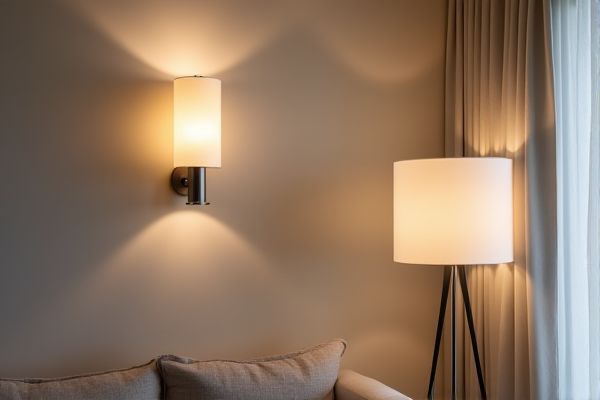
Wall sconces save floor space and provide ambient or accent lighting, ideal for smaller rooms or hallways. Freestanding lamps offer portability and flexibility in lighting placement, making them perfect for living rooms or reading nooks; explore the rest of the article to find which option suits your needs best.
Table of Comparison
| Feature | Wall Sconce | Freestanding Lamp |
|---|---|---|
| Installation | Mounted on wall | Free to move, no installation |
| Space Usage | Saves floor space | Requires floor space |
| Lighting Style | Ambient or accent lighting | Task or ambient lighting |
| Design | Fixed, blends with wall decor | Varied styles, statement pieces |
| Mobility | Stationary, fixed location | Portable, easy to relocate |
| Power Source | Hardwired or plug-in | Plug-in, battery options available |
| Ideal Use | Hallways, bathrooms, accent walls | Living rooms, reading areas, flexible lighting |
| Installation Cost | Higher, may require electrician | Lower, no installation needed |
Introduction to Wall Sconces and Freestanding Lamps
Wall sconces are decorative light fixtures mounted directly on walls, perfect for enhancing ambiance and saving floor space in your room. Freestanding lamps, also known as floor lamps, offer versatile lighting options with mobility and a variety of styles to complement your interior design. Choosing between these lighting solutions depends on your space requirements and desired lighting effects.
Key Differences Between Wall Sconces and Freestanding Lamps
Wall sconces are mounted on walls, providing focused or ambient lighting without occupying floor space, making them ideal for hallways or small rooms. Freestanding lamps, including floor lamps, offer mobility and adjustable lighting levels, enhancing versatility in living areas or reading nooks. Your choice depends on spatial constraints, lighting needs, and design preferences, balancing permanent installation with portable illumination options.
Space Requirements and Installation
Wall sconces require minimal floor space, making them ideal for small or narrow rooms, and installation involves mounting directly onto the wall, often needing professional wiring. Freestanding lamps demand more floor area but offer easy relocation without permanent installation or electrical work. Your choice hinges on available space and whether you prefer a fixed lighting solution or flexible placement options.
Light Distribution and Ambiance
Wall sconces provide focused, directional light that enhances specific areas with soft, ambient illumination, ideal for creating a cozy atmosphere without overwhelming the space. Freestanding lamps offer versatile light distribution, allowing you to adjust brightness and placement for both task lighting and overall room ambiance. Choosing between these options depends on your desired lighting effect and how you want to balance functional brightness with atmospheric warmth.
Design and Style Options
Wall sconces offer sleek, space-saving lighting with a variety of styles ranging from minimalist modern to ornate vintage, ideal for accentuating architectural features. Freestanding lamps provide versatile design options with adjustable heights, diverse bases, and shades that complement both traditional and contemporary interiors. Your choice depends on whether you prefer fixed, subtle illumination or movable, statement-making lighting to enhance your room's ambiance.
Flexibility and Mobility
Wall sconces offer fixed lighting solutions ideal for defining specific areas, while freestanding lamps provide greater flexibility and mobility, allowing you to easily relocate and adjust light as needed. Freestanding lamps are perfect for dynamic spaces where lighting requirements frequently change, complementing your ability to customize ambiance effortlessly. Choosing between the two depends on your need for permanent installation versus versatile, portable illumination options.
Energy Efficiency and Compatibility
Wall sconces often incorporate LED technology, offering superior energy efficiency compared to many freestanding lamps that may use incandescent bulbs. Their compatibility with dimmer switches and smart home systems enhances customizable lighting while reducing power consumption. Your choice depends on the balance between fixed placement and flexible mobility, but wall sconces generally provide more consistent energy-saving benefits.
Ideal Rooms and Applications
Wall sconces are ideal for hallways, bathrooms, and living rooms where space-saving and ambient lighting are priorities. Freestanding lamps best suit living rooms, bedrooms, or reading nooks that require flexible, task-oriented illumination. Your choice depends on room size, function, and whether fixed or movable lighting better complements your decor.
Cost Comparison and Maintenance
Wall sconces generally have a lower initial cost compared to freestanding lamps, but installation expenses may increase the overall price depending on your wall's wiring and mounting requirements. Freestanding lamps offer greater portability and simpler maintenance since they can be moved and cleaned easily without professional assistance. Evaluating your budget and willingness to handle installation will help you decide which lighting option provides better value for your space.
Choosing the Right Lighting Solution for Your Space
Wall sconces provide ambient or accent lighting ideal for saving floor space and enhancing wall decor, making them perfect for hallways, bedrooms, or narrow areas. Freestanding lamps offer versatile illumination and mobility, suitable for living rooms and reading nooks where adjustable lighting is needed. Selecting between wall sconces and freestanding lamps depends on room size, lighting needs, and aesthetic preferences to create balanced, functional illumination.
 homyna.com
homyna.com